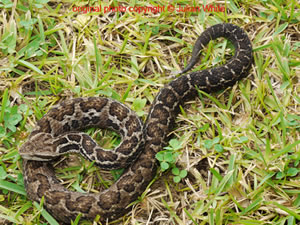Cerrophidion godmani
Godmans mountain pit viper ( Cerrophidion godmani )
Godmans mountain pit viper ( Cerrophidion godmani ) is a pit viper of the genus mountain pit viper ( Cerrophidion ).
Taxonomy
The first scientific description of the species was made in 1863 by the German zoologist Albert Günther. He arranged them first time under the name Bothriechis godmanni the Palm Terciopelos ( Bothriechis ), but also as Bothrops godmani the American Terciopelos ( Bothrops ) to. Jonathan A. Campbell & William W. Lamar convicted the type in 1989 in the genre of hook nose Terciopelos ( Porthidium ) and then in 1992 under the name Cerrophidion godmani today recognized in the genus Cerrophidion. Among species are not known.
Features
Godmans mountain pit viper reached a total length up to just 75cm, her body looks slightly stocky. The triangular, upper side plain brown head, which has a dark band between the eye and the mouth, sets it apart from the neck and upper side ( rear half ) occupied by many small scales. The pupil of the pretty little eye is slit vertically incident light. The type has 7 to 10 upper lip shields ( scutum supralabiale ), 8 to 11 lower lip shields ( scutum sublabiale ), 21 rows of dorsal scales around midbody, 130-138 abdominal signs ( Scutum ventral ) and 22 to 36 undivided under tail- shields ( scutum subcaudale ) on. The body scales are keeled. The body is gray to brownish basically and from the neck starting on the center back drawn to the tail of dark brown, oval to saddle-shaped and finely black-rimmed spots that are fused in the anterior half of the body may be a zigzag band. Side of the body are reflected in a series arranged, elongated stains. The belly is plain brown and speckled dark.
Way of life
Godmans mountain pit viper is equally tag as nocturnal. They can be under logs, between rocks or in bushes, some of them basking in the sun, observe, whenever it considers, however hidden. Likely risk of them flees towards people it is not particularly aggressive. It maintains a ground-dwelling lifestyle and captures mainly rodents, grasshoppers, and small lizards. The species propagates through Ovoviviparie, so the females give birth to live young. The cast includes 2-12 young snakes.
Toxicology
Cerrophidion godmani has a Viper -tube, retractable fangs in the front upper jaw ( solenoglyphe tooth position ) through which a produced in venom glands snake venom ( Ophiotoxin ) is injected into the bite wound. Bite accidents, with severe cases occurred, but deaths from this type are not known. Investigations of the proteome of the toxins of Cerrophidion godmani, Porthidium nasutum and Porthidium ophryomegas proved from Costa Rica for Cerrophidion godmani the presence of nine different protein families. The study also showed greater similarities in the chemistry and pharmacology of venoms of the two Porthidium - types, larger differences between their toxins to the toxin mixture of Cerrophidion godmani. This fact supports the taxonomic separation of Cerrophidion godmani of the genus Porthidium, together with already performed genetic analyzes. The poison has in human blood plasma prokoagulative effects on hemostasis on ( blood clot -promoting; possibly Disseminated intravascular coagulation ). High levels of phospholipase A ₂ has verdeutlichten strong myotoxic effects result, such as studies on mice. Besides procoagulants and Myotoxinen some authors mention further hemorrhagic activity, which may result in bleeding, and also not also include cytotoxins from.
Occurrence
The distribution area extends into Central America on the southeast of Mexico, Guatemala, Honduras, El Salvador, Nicaragua, Costa Rica and western Panama. There are settled above the sea areas between 1600 and 3200m. Among the residential habitats include both dry and wet mountain forests, rain forests, cloud forests and mountain meadows. Godmans mountain pit viper often happens regionally.










